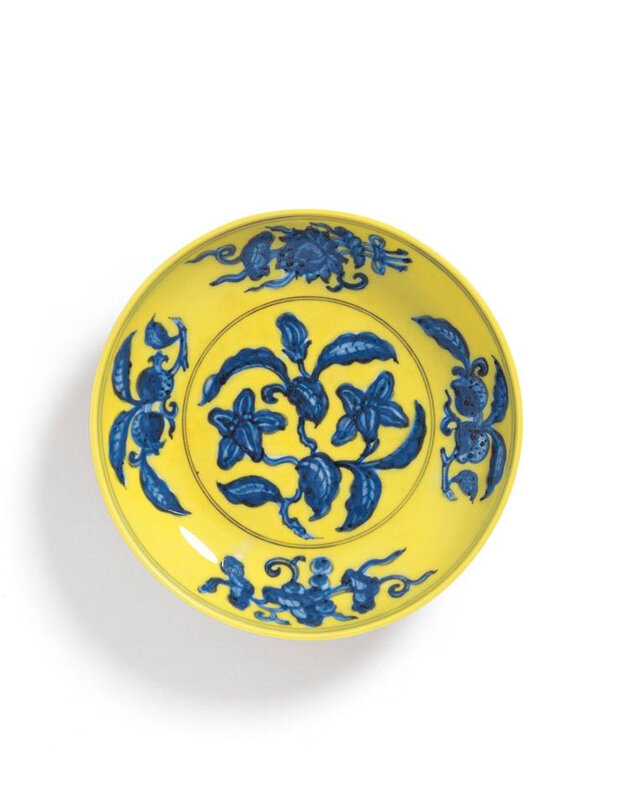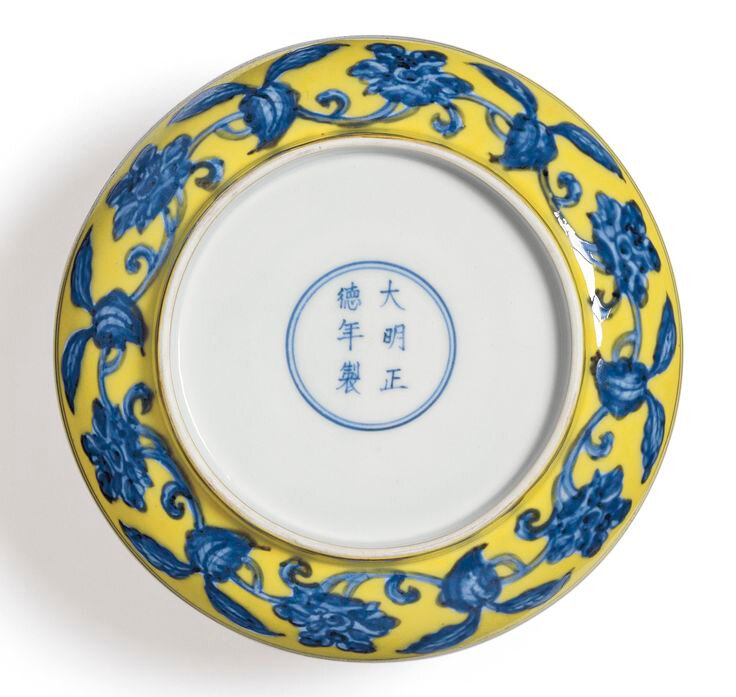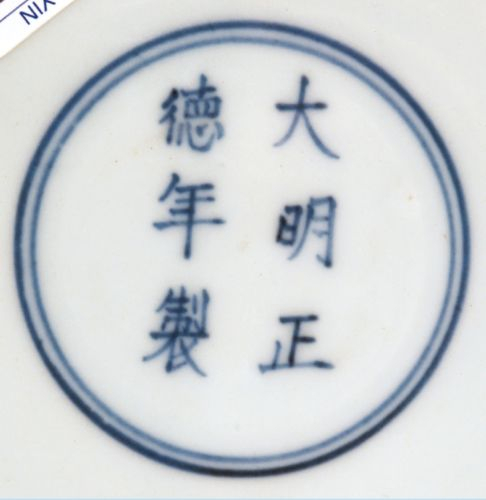An Underglaze-Blue and Yellow-Enamel 'Gardenia' Dish, Mark and Period of Zhengde (1506-1521)
Lot 43. An Underglaze-Blue and Yellow-Enamel 'Gardenia' Dish. Mark and Period of Zhengde (1506-1521); 20 cm., 7 7/8 in. Estimate 900,000 - 1,200,000 HKD. Lot sold 1,220,000 HKD. Photo Sotheby's 2012
the saucer-shaped dish with shallow rounded sides supported on a short tapered foot, the interior freely painted in shaded tones of cobalt blue with a leafy branch bearing two five-petalled gardenia blooms and a tightly closed bud, encircled on the cavetto by fruiting branches of pomegranate, grape, peach and a ribbon-tied lotus bouquet, all between double-line borders, the underside with a continuous floral scroll of large blooming roses borne on a foliate stem, between double lines at the rim and foot, all reserved on a deep yellow enamel ground, the base glazed white and inscribed with a six-character reign mark within a double ring in underglaze blue
Exhibited: Evolution to Perfection. Chinese Ceramics from the Meiyintang Collection/Evolution vers la perfection. Céramiques de Chine de la Collection Meiyintang, Sporting d’Hiver, Monte Carlo, 1996, cat. no. 126
Literature: Regina Krahl, Chinese Ceramics from the Meiyintang Collection, London, 1994-2010, vol. 2, no. 683.
Note: This striking yellow-and-blue colour scheme appears to have come into use in the Xuande reign (AD 1426-35) and the present design remained popular at Jingdezhen from the Xuande right through to the Jiajing period (AD 1522-66). Soame Jenyns, Ming Pottery and Porcelain, London, 1953, pls. 56 and 57a (rev. ed. 1988, pls. 102-4 and col. pl. H) illustrates four different examples, two of the Xuande and Chenghua (AD 1465-87) periods from the British Museum, London, a Hongzhi (AD 1488-1505) dish from the Riesco collection, Croyden, and a Zhengde (AD 1506-21) piece from the Sir Percival David Collection, now also in the British Museum; a rare Jiajing dish of this design in the Meiyintang collection is illustrated in Krahl, op. cit., vol. 2, no. 684.
Zhengde dishes of this design are known with both four and six-character reign marks. An example of each, again in the British Museum, is published in Jessica Harrison-Hall, Ming Ceramics in the British Museum, London, 2001, pls. 8: 23 and 24. Another similar dish with a six-character mark in the Shanghai Museum is illustrated in Lu Minghua, Shanghai Bowuguan zangpin yanjiu daxi/Studies of the Shanghai Museum Collections : A Series of Monographs. Mingdai guanyao ciqi [Ming imperial porcelain], Shanghai, 2007, pl. 1-41; one with a four-character mark in the Palace Museum, Beijing, is included in The Complete Collection of Treasures of the Palace Museum. Blue and White Porcelain with Underglazed Red, vol. 2, Shanghai, 2000, pl. 233, together with Chenghua and Hongzhi prototypes, pls. 230 and 231. On Zhengde versions the fruit and flower sprays can be differently distributed around the central motif.
Sotheby's. The Meiyintang Collection, Part IV - An Important Selection of Imperial Chinese Porcelains. Hong Kong, 09 oct. 2012

/https%3A%2F%2Fprofilepics.canalblog.com%2Fprofilepics%2F1%2F0%2F100183.jpg)
/https%3A%2F%2Fstorage.canalblog.com%2F03%2F02%2F119589%2F96711876_o.jpg)
/https%3A%2F%2Fstorage.canalblog.com%2F11%2F31%2F119589%2F94773502_o.jpg)
/https%3A%2F%2Fstorage.canalblog.com%2F20%2F83%2F119589%2F94772815_o.jpg)
/https%3A%2F%2Fstorage.canalblog.com%2F26%2F72%2F119589%2F75604929_o.jpg)
/https%3A%2F%2Fstorage.canalblog.com%2F59%2F60%2F119589%2F26458628_o.jpg)





/image%2F1371349%2F20240331%2Fob_2293ff_telechargement.jpg)
/http%3A%2F%2Fstorage.canalblog.com%2F01%2F95%2F119589%2F128714797_o.jpg)
/http%3A%2F%2Fstorage.canalblog.com%2F09%2F21%2F119589%2F127775838_o.jpg)
/http%3A%2F%2Fstorage.canalblog.com%2F61%2F57%2F119589%2F121460516_o.jpg)